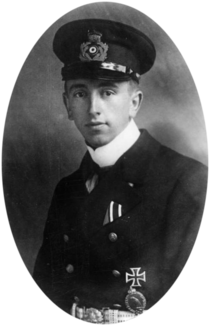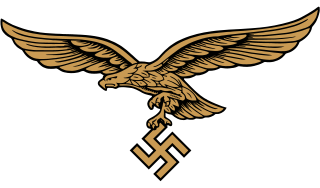Fliegerführer Afrika was part of Luftflotte 2, one of the primary divisions of the German Luftwaffe in World War II. It operated in the Mediterranean and Libya from 1941–1942. The commanders were Generalmajor Stefan Fröhlich and Generalleutnant Otto Hoffmann von Waldau, who led the German air support to the German Afrika Korps campaign during the winter of 1941–1942.

Jagdgeschwader 5 was a German Luftwaffe fighter wing during World War II. It was created to operate in the far North of Europe, namely Norway, Scandinavia and northern parts of Finland, all nearest the Arctic Ocean, with Luftflotte 5, created specifically to be based in occupied Norway, and responsible for much of northern Norway.

Theodor "Theo" Osterkamp was a German fighter pilot during World War I and World War II. A flying ace, he achieved 32 victories in World War I. In World War II, he led Jagdgeschwader 51 through the Battle of Britain and claimed a further 6 victories, in the process becoming one of only a few men to score victories in both world wars.
Jagdfliegerführer Bretagne was formed September 1943 in Rennes from Jagdfliegerführer 4, subordinated to the II. Jagdkorps. The headquarters was located at Rennes. The unit was disbanded on August 31, 1944
Jagdfliegerführer 4 was formed April 1, 1943 in Rennes subordinated to the Luftflotte 3. On September 6, 1943 the unit redesignated Jagdfliegerführer Bretagne and reformed again on September 6, 1943 in Saint-Pol-Brias from Jagdfliegerführer 2, subordinated to 4. Jagd-Division. The headquarters was located at Rennes and from 6 September 1943 in Saint-Pol-Brias. The unit was disbanded on August 31, 1944
Jagdfliegerführer 3 was formed December 21, 1939 in Wiesbaden. On September 6, 1943 redesignated Jagdfliegerführer 5, reformed again on December 27, 1943, but was disbanded in January 1944. The headquarters was located at Wiesbaden and from July 1940 in Deauville, from February 21, 1942 at Brest-Guipavas and from March 1942 again at Deauville.
Jagdfliegerführer 2 was part of Luftflotte 2, one of the primary divisions of the German Luftwaffe in World War II. It was formed 21 December 1939 in Dortmund. On 6 September 1943 the unit redesignated Jagdfliegerführer 4 and reformed again in September 1943 from Stab/Jagdfliegerführer Deutsche Bucht. The headquarters was located at Dortmund and from July 1940 in Wissant, from June 1941 at Le Touquet, and from September 1943 in Stade. The unit was disbanded in December 1943.
Jagdfliegerführer 5 was formed September 6, 1943 in Bernay from Jagdfliegerführer 3, subordinated to 5. Jagd-Division. The headquarters was located at Bernay (fr). The unit was disbanded on July 1, 1944.
Jagdfliegerführer Ostmark was formed September 6, 1943 in Vienna, subordinated to 7. Jagd-Division. The headquarters was located at Wien-Kobenzl. The unit was redesignated 8. Jagd-Division on June 15, 1944.
Jagdfliegerführer Rumänien was formed July 1943 in Otopeni (Bucharest), subordinated to Luftflotte 4. The headquarters was located at Otopeni, and from August 1944 in Budakpossibly Buzău?. The unit was disbanded on September 4, 1944.
Jagdfliegerführer 1 was part of Luftflotte 2, one of the primary divisions of the German Luftwaffe in World War II. It was formed on December 21, 1939 in Jever. Jagdfliegerführer 1 was redesignated Jagdfliegerführer Mitte on April 1, 1941. The headquarters was located at Jever and from July 1940 on in Stade.

Luftflotte 1 was one of the primary divisions of the German Luftwaffe in World War II. It was formed 1 February 1939 from Luftwaffengruppenkommando 1 in Berlin. This Luftwaffe detachment served in Estonia, Latvia, Lithuania and Immola, Finland for air support of Axis forces in area; with command offices in Malpils, Latvia,, Eastern front.
Luftflotte 4 was one of the primary divisions of the German Luftwaffe in World War II. It was formed on March 18, 1939, from Luftwaffenkommando Österreich in Vienna. The Luftflotte was redesignated on 21 April 1945, to Luftwaffenkommando 4, and became subordinated to Luftflotte 6. It was the Luftflotte 4, that was responsible for the bombing campaign of Stalingrad, where ca. 40,000 civilians died. This Luftwaffe detachment was based in Romania, Bulgaria, Southeast Poland, Hungary, Ukraine and Russian occupied territories, for supporting Axis forces; with command offices in Morczyn, Hungary, during 26 June 1944, Eastern Front.
Luftflotte 3 was one of the primary divisions of the German Luftwaffe in World War II. It was formed on 1 February 1939 from Luftwaffengruppenkommando 3 in Munich and redesignated Luftwaffenkommando West on 26 September 1944. This Luftwaffe detachment was based in German-occupied areas of Northern France, the Netherlands, Belgium, and Vichy France, to support the Axis power's forces in area. Its command offices were in Paris, France.
Jagdfliegerführer Oberitalien was part of Luftflotte 2, one of the primary divisions of the German Luftwaffe in World War II. It was formed in July 1943 in Bologna and subordinated to the Luftflotte 2. The headquarters were located at Bologna and moved to Pontecchio on March 18, 1944, moved again on July 15, 1944 to Verona.
Jagdfliegerführer Norwegen was a formation of the German Luftwaffe based in Occupied Norway during World War II. It was named for the "Fighter Leader (Jafu), Norway" and referred to the units under his command.
Jagdfliegerführer Deutsche Bucht was one of the primary divisions of the German Luftwaffe in World War II. It was formed in December 1939 at Jever for the defense of the German Bight. On 1 December 1943 the unit redesignated Jagdfliegerführer 2 and subordinated to the 2. Jagddivision. The headquarters was located at Jever and from 1943 in Stade.

X. Fliegerkorps was a formation of the German Luftwaffe in World War II, which specialised in coastal operations. It was formed 2 October 1939, in Hamburg from the 10. Flieger-Division.
Jagdfliegerführer Ostpreussen was initially part of 1st Fighter Division of the German Luftwaffe in World War II. It was formed 15 September 1943 in Neuhausen. On 8 September 1944 the Stab relocated to Königsberg-Seewiesen and subordinated to the Luftflotte 6 in January 1945. The Stab relocated again on 27 February 1945, this time to Treuenbrietzen. The unit was disbanded on 27 February 1945.






